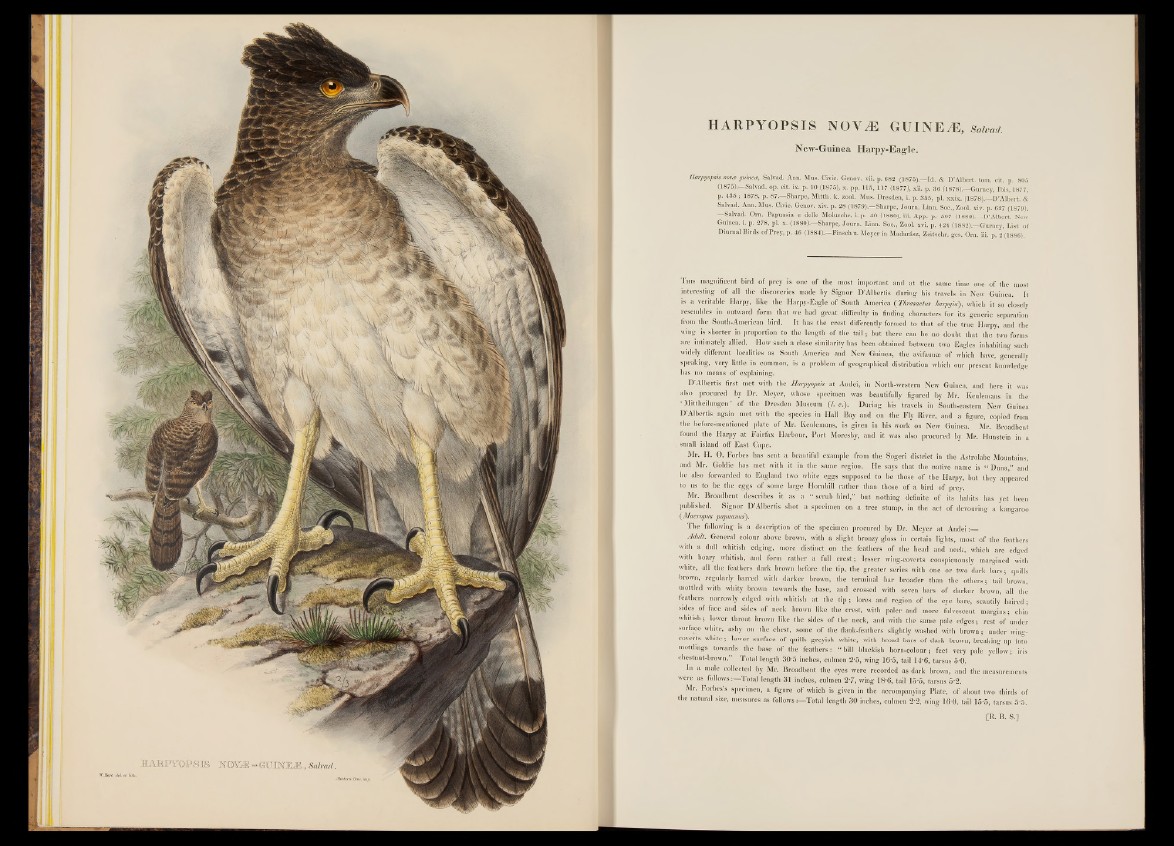
HARPYOPSIS NOVtE GUINEAS, s„w .
New-Guinea Harpy-Eag-le.
Harpy opsin nom guinea, Salvad. Ann. Hus. Civic. Genov, vii, p. 682 (1876).— Id. & D'Albert. tom. cit. p. 805
(1875). Salved, op. cit. ix. p. 10 (1S75), x. pp. 115, 117 (1877), xii. p. 36 (1878).—Gurney, Ibis, 1877,
p. 435 ; 1878, p. 87.—Sharpe, Mitth. k. zool. Mus. Dresden, i. p. 355, pi. xxix. (1878).— D’Albert. &
Salved. Ann. Mus. Civic. Genov, xiv. p. 28 (1870).—Sharpe, Journ. Linn. Soc., Zool. xiv. p. 627 (1879).
Salvad. Dm. Papnasia e. del’.e *Molr.ccho, i. p. 40 (1880), iii. App. p, 507 (1882).— D’Albert. New
Guinea, i B . 278, pi. x. (1380).—Sharpe, Journ. Linn. Soc,, Zool. xvi. p. 424 (1882).— Gurney, List of
Diurnal Birds o f Prey, p. 46 (1884).— Finsch ij. Meyer in Madardsz, Zeitschr. ges. Orn. iii. p. 2 (1886).
T h is magnificent bird o f prey is one o f the most important and at the same .time one- o f the most
interesting o f all the discoveries made by Signor, D ’Albertis during his travels in New Guinea. It
is a veritable Harpy, like the Harpy-Eagle o f South America ( Thrasaetus harpyia), which it so closely
reseuibltei: in outward form that we had great difficulty in finding characters for its generic separation
from the South-American bird. It has the crest differently formed to that o f the true Harpy, and the
wing is shorter in proportion to the length o f the t i§ ; hut there can he no doubt that the two forms
are intimately allied. How such a close similarity has been obtained between two Eagles inhabiting such
widely different localities as S . o S America (and New Guinea, the avifauii® o f which have, generally
speaking, very little in common, is a problem of geographical distribution, which our present knowledge
has no means of explaining.
D ’Albertis' first met with the Harpyopsis at Andei, in North-western New Guinea, and here | 8 was
also procured by Dr. Meyer, whose specimen was beautifully figured by Mr. Keulemans in the
‘ Mittheilungen ’ o f the Dresden Museum ( I . e .) . During his travels in South-eastern New Guinea
D ’Albertis again met with the species in Hall Bay and on the Fly River, and a figure, copied from
the before-mentioned plate o f Mr. Keulemans, is given in his work on New Guinea. Mr. Broadbent
found the Harpy at Fairfax Harbour, Port Moresby, and it was also procured by Mr. Ilnnstem in a
small island off East Cape.
Mr. H. O. Forbes has sent a beautiful example from the Sogeri district in the Astrolabe Mountains,
and Mr. Goldie has met with it in the same region. He says that the native name is “ Dana,” and
he also forwarded to England two white eggs supposed to be those o f the Harpy, but they appeared
to us to be the eggs o f some large Hornbill rather than those o f a bird o f prey.
Mr. Broadbent describes it as a “ scrub bird,” but nothing definite o f its habits has yet been
published. Signor D ’Albertis shot a specimen on a tree stump, in the act o f devouring a kangaroo
(Macropus papuanus).
The following is a description o f the specimen procured by Dr. Meyer at Andei :—
Adult. General colour above brown, with a slight bronzy gloss in certain lights, most o f the feathers
with a dull whitish edging, more distinct on the feathers o f the head and neck, which are edged
with hoary whitish, and form rather a full c rest; lesser wing-coverts conspicuously margined with
white, all the feathers dark brown before the tip, the greater series with one or two dark bars; quills
brown, regularly barred with darker brown, the terminal bar broader than the others; tail brown,
mottled with whity brown towards the base, and crossed with seven bars o f darker brown, all the
feathers narrowly edged with whitish at the tip ; lores and region o f the eye bare, scantily haired;
sides o f face and sides o f neck brown like the crest, with paler and more fulvescent margins; chin
whitish; lower throat brown like the sides o f the neck, and with the same pale edg es; rest o f under
surface white, ashy on the chest, some o f the flank-feathers slightly washed with brown; under wing-
coverts white; lower surface o f quills greyish white, with broad bars o f dark brown, breaking up into
mottlings towards the base o f the feathers: “ bill blackish horn-colour; feet very pale yellow; iris
chestnut-brown.” Total length 30 5 inches, culmen 2*5, wing 16 5, tail 14*6, tarsus 5*0.
Ill a male collected by Mr. Broadbent the eyes were recorded as dark brown, and the measurements
were as follows:—Total length 31 inches, culmen 2*7, wing 18#6, tail 15’5, tarsus 5-2.
Mr. Forbes’s specimen, a figure o f which is given in the accompanying Plate, o f about two thirds of
the natural size, measures as follows;—Total length 30 inches, culmen 2 -2, wing 1 6 0 , tail 15‘5, tarsus 5*5.
[R. B. S.]